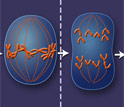News Release 05-213
Noisy Cells Disturb the Final Piece
Researchers combine molecular biology and math models to investigate variation in gene activity

Scientists are identifying factors leading to differences in genetically identical cells and people.
December 22, 2005
This material is available primarily for archival purposes. Telephone numbers or other contact information may be out of date; please see current contact information at media contacts.
A population of genetically identical cells can exhibit random differences or "noise" in gene activity that may ultimately contribute to differences in the physical characteristics of the so-called "identical" cells. Such noise, which chimes in when cellular activity is out of sync among a population of cells, has been a nuisance to scientists studying the role genes play in a number of processes.
Now, Jeff Hasty at the University of California, San Diego (UCSD) has used advanced molecular biology techniques coupled with sophisticated mathematical models to tease apart the components that make up this noise, which appears to be involved in development, evolution and even some genetic conditions.
Hasty and his UCSD colleagues report their findings in the Dec. 22 issue of the journal Nature.
Joanne Tornow, the National Science Foundation program manager for this work said, "Hasty's results epitomize the synergy created by interdisciplinary research. In this case, knowledge about a basic biological process advanced greatly when a physicist [Hasty] applied his expertise to a question seemingly unrelated to his field of training."
The genome, we have all heard, is an organism's blueprint for life, but scientists are finding more to the story. Identical twins growing up in the same house, for example, can look and behave differently. Noisy gene expression, or variation in how cells process information when genes are turned on, provides part of the explanation.
The team used advanced computer programs to rigorously analyze the variation in gene activity in strains of yeast that were engineered to produce a green fluorescence on demand. By making cell-to-cell comparisons of fluorescence levels, the researchers were able to measure the effect of variation, or noise, on a population of genetically identical cells.
Hasty's group proved the dominant source of variability in gene expression in this experiment was extrinsic, that is, caused by factors not directly related to the expression process for the particular gene. Researchers typically thought that extrinsic variability was a consequence of random environmental fluctuations in or near the cell, but Hasty's results demonstrated that variable gene expression occurred because individual cells in a population are at various stages of their growth cycle.
The variability resulting from noise is a source of diversity in an otherwise identical population of cells, and diversity facilitates adaptability to environmental changes and potential evolutionary advantages. Alternatively, as a multi-celled organism develops, noise may send one or more genetically identical cells down different paths that may result in different physical characteristics.
For more information on this research, see the UCSD press release.
-NSF-
-
At any given time, individual cells in a population are at various stages of their life cycles.
Credit and Larger Version
Media Contacts
Richard (Randy) Vines, NSF, (703) 292-7963, email: rvines@nsf.gov
Rex Graham, University of California, San Diego, (858) 822-3075, email: rgraham@soe.ucsd.edu
Program Contacts
Joanne S. Tornow, NSF, (703) 292-7134, email: jtornow@nsf.gov
Principal Investigators
Jeff Hasty, University of California, San Diego, (858) 822-3442, email: hasty@ucsd.edu
The U.S. National Science Foundation propels the nation forward by advancing fundamental research in all fields of science and engineering. NSF supports research and people by providing facilities, instruments and funding to support their ingenuity and sustain the U.S. as a global leader in research and innovation. With a fiscal year 2023 budget of $9.5 billion, NSF funds reach all 50 states through grants to nearly 2,000 colleges, universities and institutions. Each year, NSF receives more than 40,000 competitive proposals and makes about 11,000 new awards. Those awards include support for cooperative research with industry, Arctic and Antarctic research and operations, and U.S. participation in international scientific efforts.
Connect with us online
NSF website: nsf.gov
NSF News: nsf.gov/news
For News Media: nsf.gov/news/newsroom
Statistics: nsf.gov/statistics/
Awards database: nsf.gov/awardsearch/
Follow us on social
Twitter: twitter.com/NSF
Facebook: facebook.com/US.NSF
Instagram: instagram.com/nsfgov



